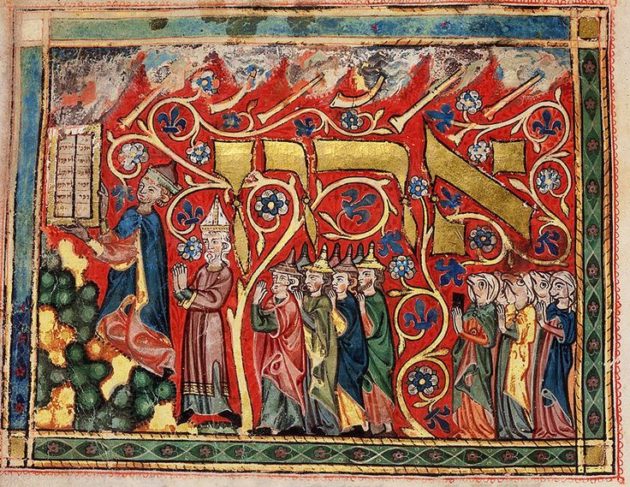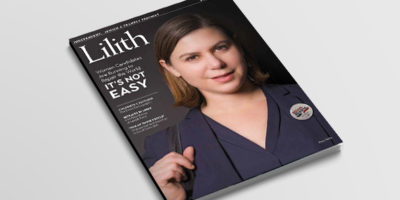I Pretended I Could Shelter My Daughter from the Patriarchy
“For much as she may act as the coequal provider or so-called matriarch within her own family, every mother must deliver her children over within a few years of their birth to the patriarchal system of education, of law, of religion, of sexual codes.” — Adrienne Rich, Of Woman Born
It began as a lie by omission.
Like many significant suburban parent-child moments, this one took place in the car. We were enjoying a mix of Hebrew songs my daughter’s day school had put together in honor of Jerusalem Day the week before. When I say we were enjoying the songs, I mostly mean that Leor was enjoying them and I was enjoying her joy.
She is five years old, so incessant questions are her preferred mode of conversation. Was I familiar, she asked excitedly, with this song or that song? (As I’m a graduate of Jewish day schools and camps, the answer was usually yes.) Had I ever sung any of them myself? (Again, thanks to various school and camp performances, this too was often the case.) My firsthand experience with these captivating songs lent me the kind of celebrity status young children often bestow upon their parents, the result of that too-fleeting stage of child development in which even mundane experiences and skills inspire awe. Basking in this unearned prestige dulled my reflexes, leaving me unprepared for the next onslaught of questions, this time focusing on her favorite song of the bunch:
Who are these girls?
How old are they?
Do they wear pink?
Who are they singing for?
These questions came in rapid-fire succession from the back seat, so quickly that I could not possibly muster an answer to one before the next demanded a response. Thankfully, she answered the last one for herself, concluding that of course they were singing for their moms and dads.
Who else would little girls sing for?
Temporarily distracted by that self-supplied conclusion, she mercifully allowed me to change the subject, to buy time before I had to confront the glaring foundational error in her line of questioning. Each and every query was based on the assumption that the high-pitched voices serenading us as we drove around town came from little girls like her. As parental moments go, this was no “where do babies come from?” I could have cleared up the misunderstanding effortlessly. And yet, something kept me from simply telling her that the voices she was hearing belonged not to girls but to prepubescent boys.
It was obvious to me that, with all of these questions, Leor was trying to establish a personal connection to a beloved piece of art. We do this all the time, especially with songs. But what role does gender play in the making of those connections? When I spent the second half of 1995 screeching out “You Oughta Know,” was it the fact that Alanis is a woman that allowed me to identify with the song, even though, at 13, I had not yet been jilted by anyone, let alone Dave Coulier? What about the connection I felt, 10 years later, to Kelly Clarkson’s “Behind These Hazel Eyes,” even though my eyes are unambiguously brown? Was it all in the jilting? (Which had sadly, by then, occurred. It wasn’t Dave.) Or was Kelly’s gender a key component? How important is hearing a voice like your own in imagining that it tells your story?
When I became a parent, I suffered from a number of intoxicating delusions, but foremost among them was the belief that I could control the world my daughter would inhabit, that I could expose her to all that would serve and empower her and filter out the rest. But children are not born just into a family. They’re born into a number of larger, sometimes overlapping groups, and for Leor one of those is Orthodox Judaism. She will gain so much from this warm and loving community. Her school and synagogue both serve as auxiliary families modeling kindness and service to others. I hope that her life will be enhanced, as mine has been, by the unique magic of Shabbat. I hope she will find meaning in the prayers she is just now learning to recite, the same prayers generations of Jews have uttered across time and space. I hope she will feel at home in a liturgy that gives voice and structure to what can often seem like an uncontrollable melee of fears and desires: the preoccupations both personal and global, cosmic and mundane, that consume us.
But this tradition is also one in which the default body, and the default voice, is male. To have a woman’s body, to speak with a woman’s voice is often to be policed and restricted. The declaration by the male voices recorded in the Talmud that kol b’isha erva, often translated as “a woman’s voice is sexual enticement,” has for centuries been used to frame the female voice as a potential impediment to male spirituality rather than a way for women themselves to encounter the divine. The usual translation of this Talmudic statement turns the prepositional b’ of b’isha into a possessive; the literal translation would be “voice in a woman,” as if it is the vessel that renders an otherwise innocuous voice dangerous. This attitude toward the voices that emanate from bodies marked as female is not unique to Judaism but its impact is discernible across a wide range of Jewish practice that identifies as Orthodox, including the existence of boys’ choirs like the one that recorded Leor’s favorite song.
So I guess the thought of telling her that the girls were actually boys seemed less like a clarification and more like a first step toward what I feared would become a gradual silencing. By assuming that the voices she heard belonged to girls, Leor unwittingly offered me the opportunity to continue a charade I began five years ago, in which I act as if she has been born into a world in which she can do anything she wishes. Do other parents play this game? For me, it usually means pretending that her spiritual life can be unequivocally active rather than passive, a religious practice characterized by presence and embodiment instead of absence and exclusion. In this religious feminist version of The Truman Show, I am the Ed Harris to her Jim Carrey, carefully choreographing her life, hiding the seams and muting the voices that would tell her it’s all a simulacrum.
But I didn’t construct that pretend world alone. Or, at least, I have taken advantage of the relative gender-blindness that Orthodox Judaism maintains for young children. Almost every week now Leor accompanies her father to our synagogue, sitting next to him and enjoying a clear sightline to the rabbi delivering his sermon. Wearing a dress and a Wonder Woman diadem, she still raises no eyebrows when rushing to the front of the men’s section to kiss the Torah as it is returned to the ark. She prepares for the start of the Jewish New Year by practicing blowing the shofar. On the holiday celebrating the simultaneous completion and beginning of the annual cycle of Torah reading, she sits triumphantly atop her father’s shoulders—a puff of pink tulle amid a sea of black and white— while the older girls and grown women, spiritual descendants of the Mahzor’s bird women, peer over the mehitza, the division between men’s and women’s section, to watch the revelry. Of all the magical powers she periodically claims to have, this, to me, is her neatest trick: existing comfortably on both sides of that divide, a three-and-a-half foot necromancer making permeable the solid wood that divides those who participate from those who simply gaze.
If she notices the division, she does not yet see it as applying to her. But that ignorance is fleeting. Soon, her gender will become the defining feature of her relationship to religious practice. She will be told that she belongs on the other side of the wood partition, the side without the Torah, without the ark. In school, her gender may dictate which Judaic texts she is allowed to study. At some point it will suddenly occur to her that she has never seen a woman blow the shofar on Rosh Hashanah. She may also be told that her voice, her body, and the way she behaves will impact the boys around her and must therefore be lowered, covered, disciplined. I have heard some people spin this as the Jewish woman’s power, a power characterized by absence, hidden from view, wielded within. If so, it is undoubtedly the world’s worst and most depressing superpower: only by disappearing can the Jewish woman save the world.
So I let the situation get out of hand. What began as a plausibly innocent omission soon became strategic, though admittedly poorly thought-out. It seemed inevitable that at some point she would mention her favorite girls’ chorus to someone who wasn’t me, and the truth would emerge. To make matters worse, I casually mentioned (boasted?) that I had, in fact, seen this group perform live on several occasions in my youth. Ah, the siren song of celebrity. I was once again some manner of hero, but at what price? In admitting I had seen the bodies from which her beloved voices emanated, I had backed myself into a corner. There could be no more plausible deniability and her questions became more specific and heartbreaking.
“Mom,” she asked, “what did they wear when you saw them in real life?” (there were sequined tuxedoes involved, she would have loved it) and “Did you thank them for this song?” (…)
In the Torah, the revelation at Sinai is preceded by the story of the Jewish people’s enslavement in, and eventual escape from, Egypt. In that narrative arc, God is described as hardening Pharoah’s heart in the face of the plagues that would have otherwise persuaded any reasonable person to set his slaves free. Leor’s earnest reverence and appreciation for the performers of this beloved piece of art broke my heart and hardened it at the same time. Reason would have dictated that I correct her belief that the girls were boys, freeing myself from the parental sin of lying and the exhausting vigilance required to maintain her adorable ignorance. But instead of poking that first, small hole in the egalitarian world in which I’ve allowed us to frolic, but in relation to which we are ultimately outsiders, I stubbornly cling to it like Og the giant to the side of the ark. I want more time with her in this place, because as much as I fear that correcting her misperception will pop some important feminist balloon I’ve tied around her wrist, I’m equally afraid that telling her the truth will make no difference at all. That it will instead reveal that pretending the Miami Boys Choir is a showcase for Jewish girls has always been more for me than for her. Because I know that another delusion of early parenthood is the idea that our children will automatically make our causes their own. And from the moment she could articulate even the most insignificant choice, I was disabused of the notion that my daughter would share my desires, motivations, or style aesthetic (see: sparkly tuxedoes). I am well aware that the questions that have haunted me since four days of labor concluded with “it’s a girl”— How do you raise a feminist in an antifeminist tradition? How do you take the good and leave the misogyny? Are they too closely interwoven to separate?—remain, for now, mine alone.
In the absence of a sea-change in Orthodoxy, I hope that those questions will one day become hers, but they may not. She may decide that feminism and her religious tradition are incompatible and choose one. While Leor is full of questions, she is still, for now, the fourth daughter at my imaginary religious feminist Seder. That is, the one who does not know to ask, for example, why we do not celebrate women’s voices as we do men’s. So I willfully keep her in this constructed world in which boys’ voices magically belong to girls, in the hopes that by the time she becomes the wise daughter—the one who knows that boys are not girls but who nevertheless asks, “what are these things that God has commanded you?”—I can answer with a challenge that I hope she will accept: make all of these boys’ voices your own and save the world.

Courtesy of the British Library, 14th century, Southern Germany.
Who Are These Bird Women?
Note the gendered difference in gaze…
In a depiction of the revelation at Sinai found in a fourteenth century German Mahzor, Moses stands on the mountain receiving the tablets containing the Ten Commandments. His brother Aaron, who will become the first high priest, stands behind him and in front of a group of men. Hands clasped in supplication, the men gaze steadily ahead, ready and determined to receive the word of God. Behind them, separated by a floriated partition, are the women. They too adopt a posture of prayer, hands together at their breasts, but they are separate and they are registered as Other. Instead of the human features found on the men, each of the women has a hybrid form: a human body and a bird head. These bird women are both a part of the scene and distant from it. Most of them do not appear to be looking toward the Sinaitic scene. Their gaze is instead directed up above, giving the impression that they are ignoring the spectacle of the mountain in favor of the large gold letters that spell out the word aron, Hebrew for ark.
What is the meaning of this gendered difference in gaze? Are we supposed to imagine that the women are craning their necks from the nosebleed seats, struggling to see the world-altering religious revelation unfolding in proximity to them, if not exactly for them? Or perhaps, in the absence of a clear sightline to the main event, they have given up on its visual component and have settled for the auditory, the sounds coming from the trumpets protruding from the heavens at the top of the page.
Or maybe, at this early stage of Jewish peoplehood, these women already sense that their revelation must ultimately come from somewhere else.
Sara Fredman is a writer living in St. Louis. She recently completed a Ph.D. in medieval English literature at Washington University.



